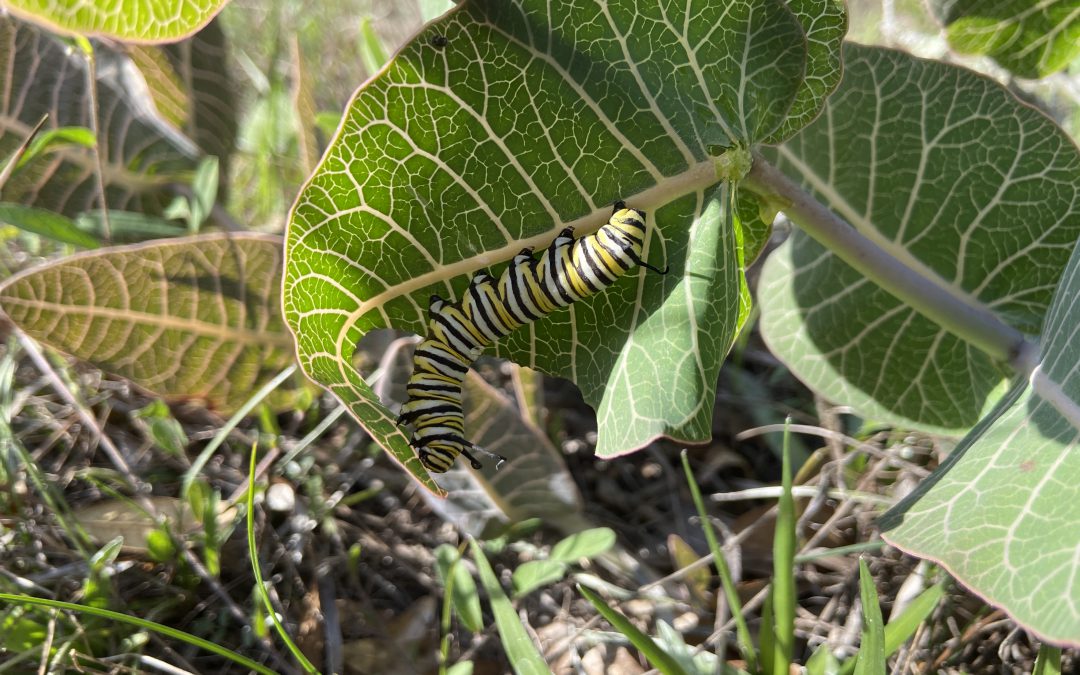
by Mary Salinas | Aug 20, 2021
On August 12, 2021, our panel answered questions on a wide variety of landscape topics. Maybe you are asking the same questions, so read on!
Ideas on choosing plants
What are some perennials that can be planted this late in the summer but will still bloom through the cooler months into fall?
Duranta erecta ‘Sapphire Showers’ or ‘Gold Mound’, firespike, Senna bicapsularis, shrimp plant, lion’s ear
Where can native plants be obtained?

Dune sunflower, Helianthus debilis. Photo credit: Mary Salinas UF/IFAS Extension.
Gardening Solutions: Florida Native Plants – see link to FANN: https://gardeningsolutions.ifas.ufl.edu/plants/ornamentals/native-plants.html
What are some evergreen groundcover options for our area?
Mondo grass, Japanese plum yew, shore juniper, ajuga, ferns such as autumn fern.
What are some ideas for partial morning sun butterfly attracting tall flowers to plant now?
Milkweed, salt and pepper plant, swamp sunflower, dune sunflower, ironweed, porterweed, and salt bush.
I’m interested in moving away from a monoculture lawn. What are some suggestions for alternatives?
Perennial peanut, powderpuff mimosa, and frogfruit.
We are new to Florida and have questions about everything in our landscape.
Florida-Friendly-Landscaping TM Program and FFL Web Apps: https://ffl.ifas.ufl.edu/
https://ffl.ifas.ufl.edu/resources/apps/
UF IFAS Gardening Solutions: https://gardeningsolutions.ifas.ufl.edu/
What are some of the top trends in landscaping today?
Houseplants, edible gardens, native plants, food forests, attracting wildlife, container gardening, and zoysiagrass lawns
Edibles

Artwork broccoli is a variety that produces small heads. Photo credit: Mary Salinas UF/IFAS Extension.
What vegetables are suitable for fall/winter gardening?
Cool Season Vegetables: https://gardeningsolutions.ifas.ufl.edu/plants/edibles/vegetables/cool-season-vegetables.html
North Florida Gardening Calendar: https://edis.ifas.ufl.edu/publication/EP451%20%20%20
Florida Vegetable Gardening Guide: https://edis.ifas.ufl.edu/publication/vh021
How can I add herbs to my landscape?
Herbs in the Florida Garden: https://gardeningsolutions.ifas.ufl.edu/plants/edibles/vegetables/herbs.html
My figs are green and hard. When do they ripen?
Why Won’t My Figs Ripen: https://www.lsuagcenter.com/profiles/rbogren/articles/page1597952870939
What is best soil for raised bed vegetable gardens?
Gardening in Raised Beds: https://edis.ifas.ufl.edu/publication/EP472
And there are always questions about weeds
How can I eradicate cogongrass?
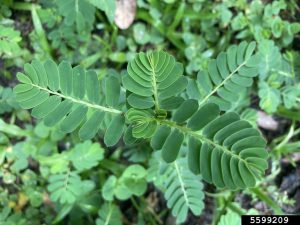
Chamber bitter is a troublesome warm season weed in our region. Photo credit: Brantlee Spakes Richter, University of Florida, Bugwood.org
Cogongrass: https://edis.ifas.ufl.edu/publication/WG202
Is it okay to use cardboard for weed control?
The Cardboard Controversy: https://gardenprofessors.com/the-cardboard-controversy/
What is the best way to control weeds in grass and landscape beds?
Weed Management Guide for Florida Lawns: https://edis.ifas.ufl.edu/publication/EP141
Improving Weed Control in Landscape Planting Beds: https://edis.ifas.ufl.edu/pdf/EP/EP52300.pdf
Landscape practices
Can ground water be brackish and stunt plants?
Reclaimed Water Use in the Landscape: https://edis.ifas.ufl.edu/publication/ss545
How can I prevent erosion from rainwater runoff?
Stormwater Runoff Control – NRCS: https://www.nrcs.usda.gov/wps/portal/nrcs/detail/national/water/?cid=nrcs144p2_027171
Rain Gardens: https://gardeningsolutions.ifas.ufl.edu/design/types-of-gardens/rain-gardens.html
And https://gardeningsolutions.ifas.ufl.edu/pdf/articles/rain-garden-manual-hillsborough.pdf
What is the best time of the year to propagate flowering trees in zone 8B?
Landscape Plant Propagation Information Page – UF/IFAS Env. Hort: https://hort.ifas.ufl.edu/database/lppi/
Which type of mulch works best on slopes greater than 3 percent?
Landscape Mulches: How Quickly do they Settle?: https://edis.ifas.ufl.edu/publication/FR052
When should bulbs be fertilized?
Bulbs and More – UI Extension: https://web.extension.illinois.edu/bulbs/planting.cfm
Should I cut the spent blooms of agapanthus?
Agapanthus, extending the bloom time: https://gardeningsolutions.ifas.ufl.edu/plants/ornamentals/agapanthus.html
http://blogs.ifas.ufl.edu/wakullaco/2020/10/07/extending-bloom-time/
Plant questions
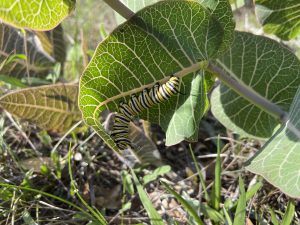
Monarch caterpillar munching on our native sandhill milkweed, Asclepias humistrata. Photo credit: Mary Salinas, UF IFAS Extension.
I planted native milkweed and have many monarch caterpillars. Should I protect them or leave them in nature?
It’s best to leave them in place. Featured Creatures: Monarch Butterfly: https://edis.ifas.ufl.edu/pdf/IN/IN780/IN780-Dxyup8sjiv.pdf
How does Vinca (periwinkle) do in direct sun? Will it make it through one of our panhandle summers? Can I plant in late August?
Periwinkles and No more fail with Cora series: https://gardeningsolutions.ifas.ufl.edu/plants/ornamentals/periwinkles.html#:~:text=Plant%20your%20periwinkles%20where%20they,rot%20if%20irrigated%20too%20frequently.
Insect and disease pests
What to do if you get termites in your raised bed?
The Facts About Termites and Mulch: https://edis.ifas.ufl.edu/publication/IN651
How to combat fungus?
Guidelines for ID and Management of Plant Disease Problems: https://edis.ifas.ufl.edu/publication/mg442
Are there preventative measures to prevent diseases when the humidity is very high and it is hot?
Fungi in Your Landscape by Maxine Hunter: http://blogs.ifas.ufl.edu/marionco/2020/01/16/fungi-in-your-landscape/
If you missed an episode, check out our playlist on YouTube https://www.youtube.com/watch?v=bp0HfdEkIQw&list=PLhgoAzWbtRXImdFE8Jdt0jsAOd-XldNCd

by Daniel J. Leonard | Jul 22, 2021
If you’ve taken care of your yard properly from spring green-up to now (mid-July), you might think you can comfortably coast into the cool temperatures of fall without any problems. You would be mostly right, save for one extraordinarily tough weed that waits until the depths of summer to rear its troublesome head: Doveweed (Murdania nudiflora).
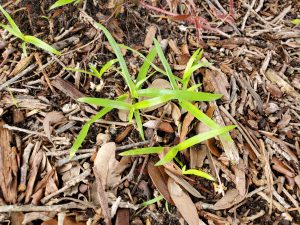
Doveweed seedlings just emerged on July 9, 2021. Photo courtesy of Daniel Leonard.
Doveweed is an insidious invader of Panhandle lawns. In the Panhandle, Doveweed germinates (sprouts) long after most other summer annual weeds, from late May-June when soil temperatures reach ~70°F. This allows it to sneakily avoid spring pre-emergent herbicide applications and even early summer post-emergent applications that target common weeds like Florida Pusley, Spurge species, and others. Doveweed also looks an awful lot like many of our common lawn turfgrasses, especially Centipede and St. Augustine Grass. It possesses thick, shiny, grass-like foliage and even grows in a spreading, low to the ground fashion. This mimicry causes many homeowners to not realize there is a problem until it’s too late. Once Doveweed is mature and displaying its characteristic purple flowers, it is very difficult to control. Finally, Doveweed is extremely tough and aggressive, particularly thriving in moist areas of the lawn. In these areas, Doveweed can easily outcompete the desirable turfgrass and, without intervention by you, will soon have the whole lawn to itself.
Controlling Doveweed is no easy task and requires a combination of practices to keep it out of your lawn. The first line of defense against any weed, Doveweed included, is through proper cultural practices. In turfgrass lawns, this means ensuring that you mow your lawn regularly and at the proper height (2.5” or so for Centipedegrass), keeping the lawn irrigated during droughty periods, fertilizing based on a soil test, etc. Being diligent in the above tasks will go a long way to ensuring that your turfgrass is healthy and better able to ward off a Doveweed invasion. However, even when homeowners maintain their turf perfectly, chemical herbicides are usually required to keep Doveweed at bay.
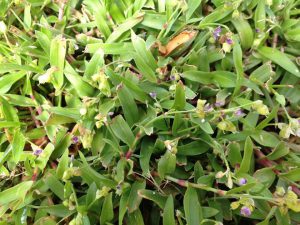
Doveweed patch in St. Augustine Sod.
While many commonly used homeowner herbicides are not effective on Doveweed, there are several quality options at your disposal.
- Doveweed is most easily controlled with preemergent herbicides, specifically one of the following: Atrazine, Pennant Magnum (S-metolachlor), Tower (dimethenamid), and Specticle (indaziflam). The issue with pre-emergents is that most folks shelve them after spring application in February or March. Since these products lose their efficacy after 4-6 weeks, Doveweed’s emergence in May is undeterred. To obtain control on Doveweed with these products, split the spring application and apply once in late Feb/early March and again in mid-late April.
- Doveweed can also be controlled by post-emergent herbicides after it is up and growing, though multiple applications may be required. The most effective formulations contain a combination of 2,4-D or Dicamba and other herbicides. While most of these products have at least fair efficacy on Doveweed, stronger, more expensive products like Celsius, Tribute Total and others provide better results.
- If Doveweed has already displaced turfgrass in large areas of your lawn, you may unfortunately be better off to make an application of a non-selective herbicide like glyphosate (Roundup), kill out the entire area of infestation and start over by resodding.
While Doveweed is a major problem in Panhandle lawns, it doesn’t have to be in yours! By keeping your turf healthy with proper cultural practices and making timely applications with effective herbicides, your lawn can be a Doveweed free zone! For assistance in Doveweed identification in your lawn, help choosing herbicides and calculating application rates, or any other horticultural information, contact us at the UF/IFAS Calhoun County Extension office! Happy Gardening!
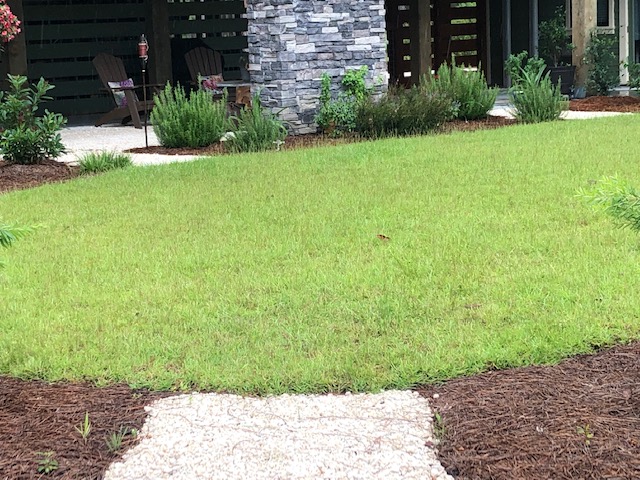
by Stephen Greer | Jul 1, 2021

Photo Courtesy: Stephen Greer
Lawn areas come in all sizes and shapes. Some are large open expanses providing long views and others are smaller versions surrounded by shrubs and trees creating a more private and secluded setting. There are a number of reasons for reducing the size of a lawn with some coming into play with your decisions. A home lawn is often an important part of the landscape that provides a place to play outdoors from picnicking, tossing the ball to taking a quite stroll.
Maintaining a healthy lawn is important to an overall performance of this part of the landscape. Several factors are involved in the success in keeping a strong and resilient lawn. Understanding the needs of a grass to remain healthy involve soil testing to address soil pH and nutrient needs plus water challenges. Misuse of fertilizer and over irrigation can be costly to you and to the overall health of the lawn. These decisions can lead to reducing lawn size to managing cost or removing underused areas.
There are big benefits to reducing your lawn from saving time in mowing, trimming and other manicuring needs to saving energy costs involving the lawn mower not to mention reducing pollution from the mower or weed eater. The reduced amounts of pesticides needed to manage weeds and disease to the lawn saves time and money.
Another way to look at the reducing the size of our lawn is there will be more space for expanding plant beds and potential tree placement. These settings increase the opportunities for a more biodiverse landscape providing shelter, protection and food options for birds and other wildlife.
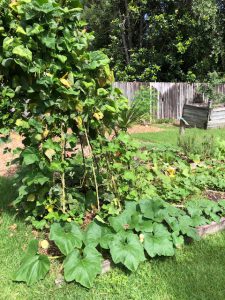
Photo Courtesy: Stephen Greer
The lawn can serve as a transition space that leads from one garden room space to another, while still offering a location to bring the lawn chair out to enjoy all that is around your lawn. Lawns and the landscape are ever changing spaces, especially as your trees and shrubs grow and mature to sizes that can directly impact the lawn performance. Often levels of shade will diminish edges and other areas of the lawn. This often will define the reduction of the lawn size moving going forward. Just remember that lawns and landscapes occupy a three-dimensional space involving the horizontal, vertical and overhead spaces. Just look around and think about what is best for you, your family and the setting.Are you more interested in developing other parts of the landscape? With many of us spending more time at home over the last year plus it gave time to think about the outdoor areas. Growing our own vegetables may be a new or expanding part of the landscape with the use of raised beds or interplanting into the existing landscape. Gardening can assist in reducing stress while at the same time providing that fresh tomato, lettuce, herbs and other fun healthy produce.
What ever your decisions are enjoy the lawn and landscape. For additional information, contact your local University of Florida IFAS Extension office located in your county.
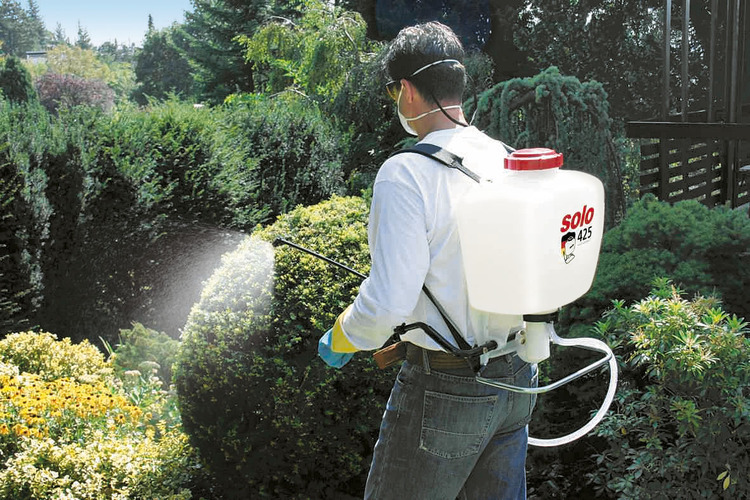
by Daniel J. Leonard | Jun 24, 2021
Nutsedge, commonly called “nutgrass”, is one of the most important and difficult to control weed pests in the world. Found in nearly every growing situation, from crop fields and vegetable gardens to landscapes and turfgrass lawns, I bet every person reading this has contended with controlling nutsedge at some point! Nutsedge (a common term to describe several species of weeds in the genus Cyperus) not only reduces curb appeal, but also h as a detrimental effect on desirable plantings around it. Because of its aggressive nature and dense root system, it competes heavily with “good” plants for water, light, and nutrients, causing the plants we are trying to grow to suffer. This is a weed that you definitely do not want in your lawn or landscape!
To keep nutsedge at bay, it’s important to know a few facts about it. First, “nutgrass” is not a grass at all, but a totally different class of plants known as sedges. This is important because selective herbicides used to kill grassy weeds will not affect nutsedge. Though they’re grass look-alikes, sedges can be distinguished by their distinctive triangular shaped stems. You can actually feel the three edges of nutsedge stems. If ever in doubt over whether a weed is a grass or a sedge, remember “sedges have edges”. Most sedges are perennials, dying back to the ground each year in winter and reemerging from tubers, called “nutlets”, that can survive over a foot under the ground! Also, while sedges generally prefer wet areas, they aren’t very particular about where they grow and are equally at home in sand or clay, wet or dry, and sun or shade. All these characteristics make sedges hard to control and cause much consternation amongst gardeners!
The first line of defense in controlling nutsedge is keeping a dense cover over any bare ground. In lawns, this means maintaining a thick, healthy turf as weeds love to enter lawns through thin or patchy areas. This can be accomplished by mowing regularly, fertilizing appropriately based on a soil test, not overirrigating while also not allowing the grass to suffer badly during droughty periods. Easier said than done. In landscape beds, preventative control is a little easier. First, as nutsedge prefers wet areas, only irrigate when it is needed. During much of the year, most established landscapes can get by on rainfall alone. Next, simply maintain a roughly 3” layer of pine straw, wood chips, pine bark, or other natural mulch of your choice. Doing so will reduce all manner of weeds, nutsedge included, and is generally beneficial for ornamental plants as well! I do not recommend landscape fabric as it is a pain to install and remove and is not extremely effective at reducing nutsedge as the sedge’s sharp growing points punch right through most plastic or fabric mulches.
Though mulching and other preventative measures can reduce nutsedge numbers, those methods alone are usually not enough and chemical herbicides are required. Fortunately, in Panhandle lawns and landscapes, there are several excellent, readily available options for sedge control: imazaquin and halosulfuron.
- Imazaquin is the active ingredient in the common product Image Kills Nutsedge and has good activity on most sedge species. It can be applied safely to all the common turfgrass species grown in the area and can even be sprayed right over the top of most common ornamental landscape plants!
- Halosulfuron is the active ingredient in the product Sedgehammer (available online or at specialty landscape supply stores) and several other generic products. Halosulfuron products provide excellent control of all nutsedge species and are safe to use in all turfgrass species found in Florida. While most landscape plants are tolerant of halosulfuron application, use care and try to only spray it on sedge weeds to avoid any unwanted yellowing or damage.
While both products begin working immediately, it may take several weeks to see sedge weeds start suffering and patience is necessary! Though both products are effective, follow up applications 3-4 weeks later are generally necessary to clean up any surviving sedge.
Nutsedge is a nasty little weed that can be difficult, though not impossible to manage. Through some smart cultural practices and timely applications of either imazaquin or halosulfuron, you can keep your lawn and landscapes nutsedge free! For more information about nutsedge control on your property or any other agricultural or horticultural topic, contact your local UF/IFAS County Extension office! Happy Gardening!
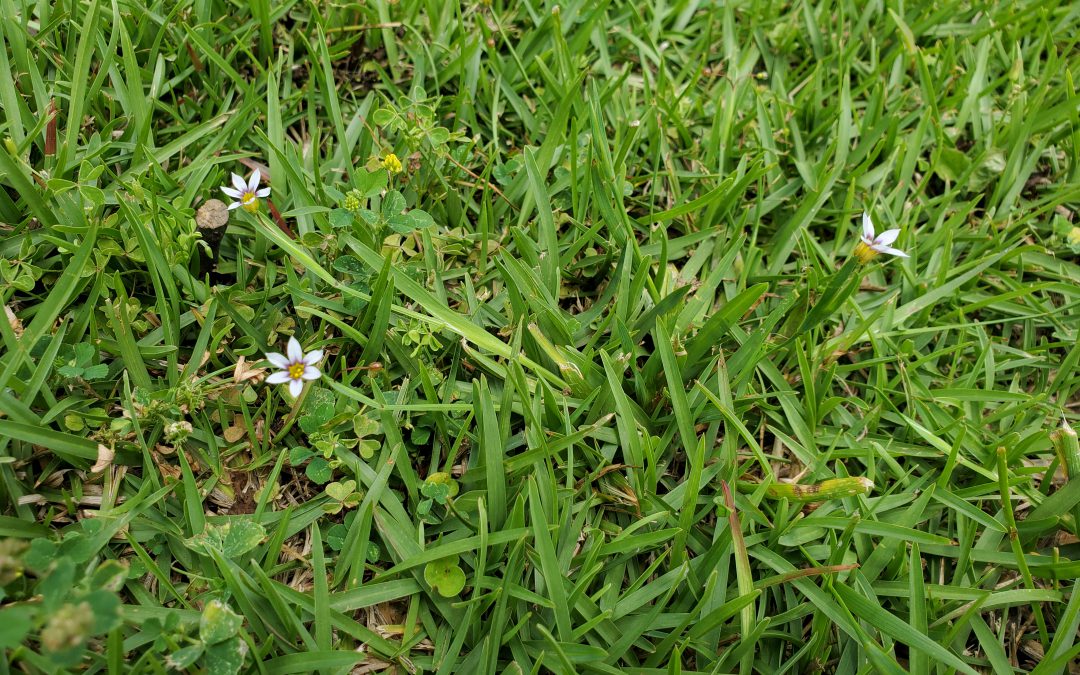
by Daniel J. Leonard | Apr 8, 2021
The line separating what is a weed and what isn’t often comes down to where the “weed” is growing and who is managing the area it’s growing in. Blue Eyed Grass (Sisyrinchium rosulatum), one of the most complained about lawn weeds this winter/spring falls squarely in that category! Native plant enthusiasts and homeowners looking to add native wildflowers to their landscape value the plant for its low maintenance, star-shaped blue blossoms in spring. Professional and home turfgrass managers, however, loathe the plant as it masquerades as grass to the untrained eye, looks messy in the cool months, and can displace turf during spring green up. While Blue Eyed Grass can be a pretty landscape plant, our focus today is on learning why it is such an annoying weed in turfgrass areas and exploring control options if it becomes a problem!
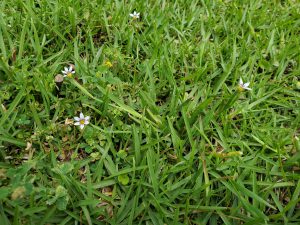
Blue Eyed Grass (Sisyrinchium rosulatum) in a Centipedegrass lawn in late March. Photo courtesy of Daniel Leonard.
For starters, Blue Eyed Grass (BEG) is not even a grass, though it does look an awful lot like one! It is actually a member of the Iris family and is more closely related to spring beauties like Gladiolus, Iris, and Crocus than any turfgrasses. The flowers, appearing late March through April, are a dead giveaway that we aren’t dealing with a grass, as are the flat leaves arranged in bunched fan-shaped rosettes. BEG is considered a winter annual plant in Florida, meaning it sprouts from seed in the fall, grows through the winter, then flowers and sets seed in the spring. Because it grows while lawn grass is dormant, it is very noticeable during its entire lifespan. Though BEG can tolerate a range of soil types, it prefers to grow in moist areas, making it right at home in Panhandle lawns and landscapes in the winter as we experience regular to excessive rainfall throughout our cool season.
All the above characteristics make BEG an annoying weed in lawns. It hides in turfgrass very well until the turf goes dormant in the dead of winter, leading most homeowners to ignore it until it becomes a problem in the spring. At this point, BEG is nearing maturity and is more difficult to control without damaging the turfgrass. BEG also thrives in our climate and can outcompete poorly managed turfgrass, especially if the lawn exhibits the soggy, compacted conditions that heavy lawn foot traffic and winter/spring rainfall cause. So, what is a homeowner to do?
The first step in controlling BEG is maintaining a healthy turf. Ensure you’re treating your turf well during the growing season by fertilizing appropriately, mowing frequently at the correct height, and irrigating properly. Sending turf into the dormant season stressed by poor growing season management is an invitation to winter weeds. Other cultural practices that can help mitigate troublesome winter weeds like BEG are periodic mowing during the cool season to prevent weeds from going to seed and being diligent about not frequently driving on, parking cars on, or otherwise excessively compacting the soil, a common cause of unhealthy turfgrass.
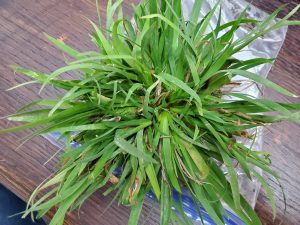
Blue Eyed Grass clump brought into the Calhoun County Extension office for identification and control recommendations in February 2021. Photo courtesy of Daniel Leonard.
After implementing the above cultural practices in your lawn management regime, you may also need chemical herbicides to achieve a clean cool season lawn. There are two basic options for BEG control. First, a fall (mid-late October) application of a pre-emergent herbicide like dithiopyr, prodiamine, or pendimethalin can be very effective at preventing winter weeds from occurring at all. If you happen to miss this fall pre-emergent application, a timely post-emergent application of 2,4-D or other general broadleaf herbicides works nicely as well. (BEG and other cool season weeds are best controlled with post-emergent herbicides in December and January before they mature and begin to set seed. Plan applications accordingly!)
While Blue Eyed Grass can be an attractive addition to the landscape, it is never welcome in turfgrass! To prevent this and weeds from becoming a problem, use smart cultural practices to maintain a healthy turf and make timely herbicide applications when needed. For more information on controlling Blue Eyed Grass and other winter weeds, contact your local UF/IFAS Extension office!
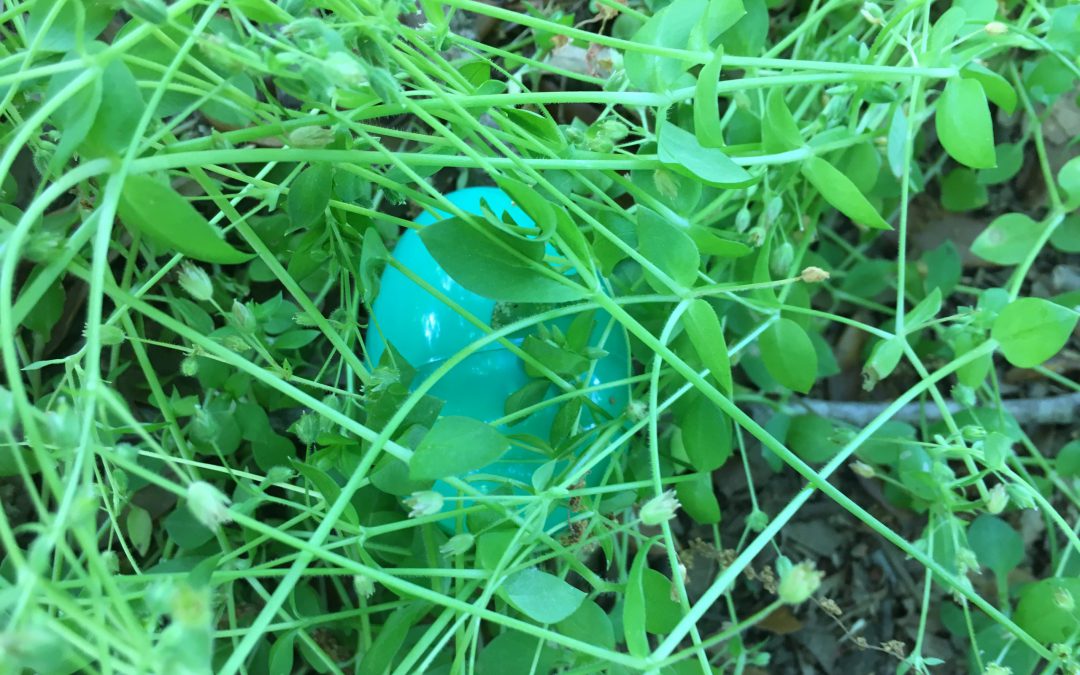
by Larry Williams | Mar 25, 2021
As a boy in a small town in Georgia we had a St. Augustinegrass lawn. My dad started the lawn before I was born. That lawn was still doing fine when I left for college at age seventeen. I don’t remember weeds in the lawn during summer months. I do fondly remember winter “weeds” in that lawn.
To see clumps of winter annuals in our yard and in neighbors’ yards was a natural part of the transition from winter to spring. They added interest to what

Blue Easter egg hidden in chickweed. Photo credit: Larry Williams
would have been a plain palette of green. It was expected to see henbit with its square stiff stems holding up a display of small pinkish purple flowers in late winter and early spring. A clump of henbit was a great place to hide an Easter egg, especially a pink or purple one.
Wild geranium, another common winter annual, offered another good hiding place for Easter eggs with its pink to purple flowers. Large clumps of annual chickweed would nicely hide whole eggs. Green colored eggs would blend with chickweed’s green leaves.
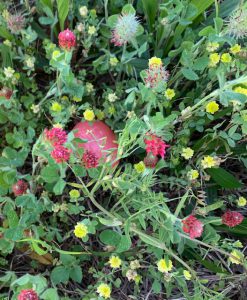
Pink Easter egg hidden in crimson clover & hop clover mix. Photo credit: Larry Williams
Crimson clover with its reddish flowers, hop clover and black medic with their bright yellow flowers were good hiding places for Easter eggs. Plus clovers add nitrogen back to our soils.
I never remember my dad using any weed killer, he rarely watered. The lawn was healthy and thick enough to be a deterrent to summer weeds. But during fall and winter as the lawn would naturally thin and go dormant, winter annual weeds would run their course.
I’ve heard that the sense of smell provides our strongest memories. I remember the first mowing of the season with the clean smell of chlorophyll in the spring air. It was refreshing. Once mowed and as the heat took its toll, by late April or mid-May, these winter annual weeds were gone. What was left was a green lawn to help cool the landscape as the weather warmed. The lawn was mowed high as St. Augustine should be, played on and typically not worried with.
Most people have winter weeds in their lawns that let us know spring is near. Perhaps we worry too much with these seasonal, temporary plants that may have wrongly been labeled as weeds. Besides, how long have we been doing battle with these weeds and they are still here. Most lawns have countless numbers of winter annual seeds awaiting the cooler temperatures and shorter days of early winter to begin yet another generation. By May they are gone.


















